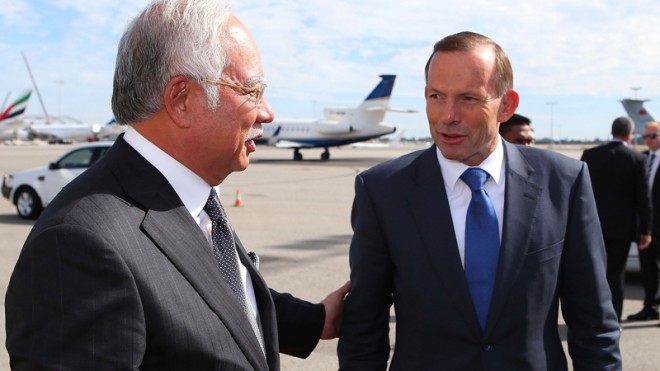
Australian Prime Minister Tony Abbott, right, chats with his Malaysian counterpart Najib Razak at Perth International Airport as Razak prepares to depart Australia after his visit during the search of the missing Malaysia Airlines flight MH370, in Perth, Australia, Thursday, April 3, 2014. Najib arrived at the Australian air force base serving as a hub for the search for Flight 370, as the coordinator of the multinational search effort warned that the hunt for the jetliner was one of the most complicated searches in history. Najib met with Abbott and received a briefing by Angus Houston, the head of a joint agency coordinating the search. (AP Photo/Paul Kane, Pool)
PERTH, Australia – Search crews hunting for Malaysia Airlines Flight 370 headed back out to a remote patch of the Indian Ocean on Friday, a day after leaders of the two countries heading multinational efforts to find the missing jetliner vowed that no effort would be spared to give closure to the families of those on board.
More resources were committed to the search Friday, with 14 planes and nine ships planning to scour a 217,000 square kilometer (84,000 square mile) expanse about 1,700 kilometers (1,100 miles) northwest of Perth, the Joint Agency Coordination Center overseeing the search said. Ten planes were involved in Thursday’s search.
On Thursday, Malaysian Prime Minister Najib Razak flew to Australia for briefings on the search for the Boeing 777 and to meet with his Australian counterpart, Tony Abbott, whose country is overseeing the hunt in a desolate expanse of the Indian Ocean.
“It is a very difficult search — the most difficult in human history. But as far as Australia is concerned, we are throwing everything we have at it,” Abbott said in a media appearance with Najib.
No trace of the jetliner has been found nearly four weeks after it vanished in the early hours of March 8 on a flight from Kuala Lumpur to Beijing with 239 people on board.
The coordination center overseeing the search described weather in the search area on Friday as fair, with visibility about 10 kilometers (6 miles) and cloud above the optimum search altitude of 1,000 feet (305 meters).
Najib, whose government has been harshly criticized by some victims’ families for giving sometimes conflicting information about the flight and for the slow pace of the investigation, said everyone involved in the search is thinking of the families of victims who are waiting desperately for news.
“I know that until we find the plane, many families cannot start to grieve,” Najib said. “I cannot imagine what they are going through. But I can promise them that we will not give up.”
“We want to provide comfort to the families and we will not rest until answers are indeed found. In due time, we will provide a closure for this event,” he said.
Najib met with Abbott at the Australian base near Perth that is serving as the hub for the search effort. They were briefed by Angus Houston, the head of the agency overseeing the search.
Although Australia is coordinating the ocean search, the investigation into the tragedy ultimately remains Malaysia’s responsibility. Najib said Australia had agreed to be an “accredited representative in the investigation,” and would work with Malaysia on a comprehensive agreement on the search.
Earlier this week, officials warned the investigation may never fully answer why the airliner disappeared. A dearth of information has plagued investigators from the moment the plane’s transponders, which make the plane visible to commercial radar, were shut off.
Military radar picked up the jet just under an hour later, way off course on the other side of the Malay Peninsula. Authorities say that until then, its “movements were consistent with deliberate action by someone on the plane,” but have not ruled out anything, including mechanical error.
Police are investigating the pilots and crew for any evidence suggesting they may have hijacked or sabotaged the plane. The backgrounds of the passengers have been checked by investigators and nothing suspicious has been found.
On Thursday, the British navy’s HMS Echo reported one alert as it searched for sonic transmissions from the missing plane’s flight data recorder, but it was quickly discounted as a false alarm, the search coordination center said.
False alerts can come from animals such as whales, or interference from shipping noise.
The Ocean Shield, an Australian warship carrying a U.S. device that detects “pings” from the plane’s flight recorders, was expected to arrive by Saturday.
No confirmed trace of the plane’s wreckage has been found. Houston has said there is no timeframe for ending the search, but acknowledged a new approach will eventually be needed if nothing turns up.
Spotting wreckage is key to narrowing the search area and ultimately finding the plane’s data recorders, which would provide a wealth of information about the condition the plane was flying under and the communications or sounds in the cockpit.
The data recorders emit a ping that can be detected by special equipment in the immediate vicinity. But the battery-powered devices stop transmitting the pings about 30 days after a crash.
Locating the data recorders and wreckage after that is possible, but becomes an even more daunting task.